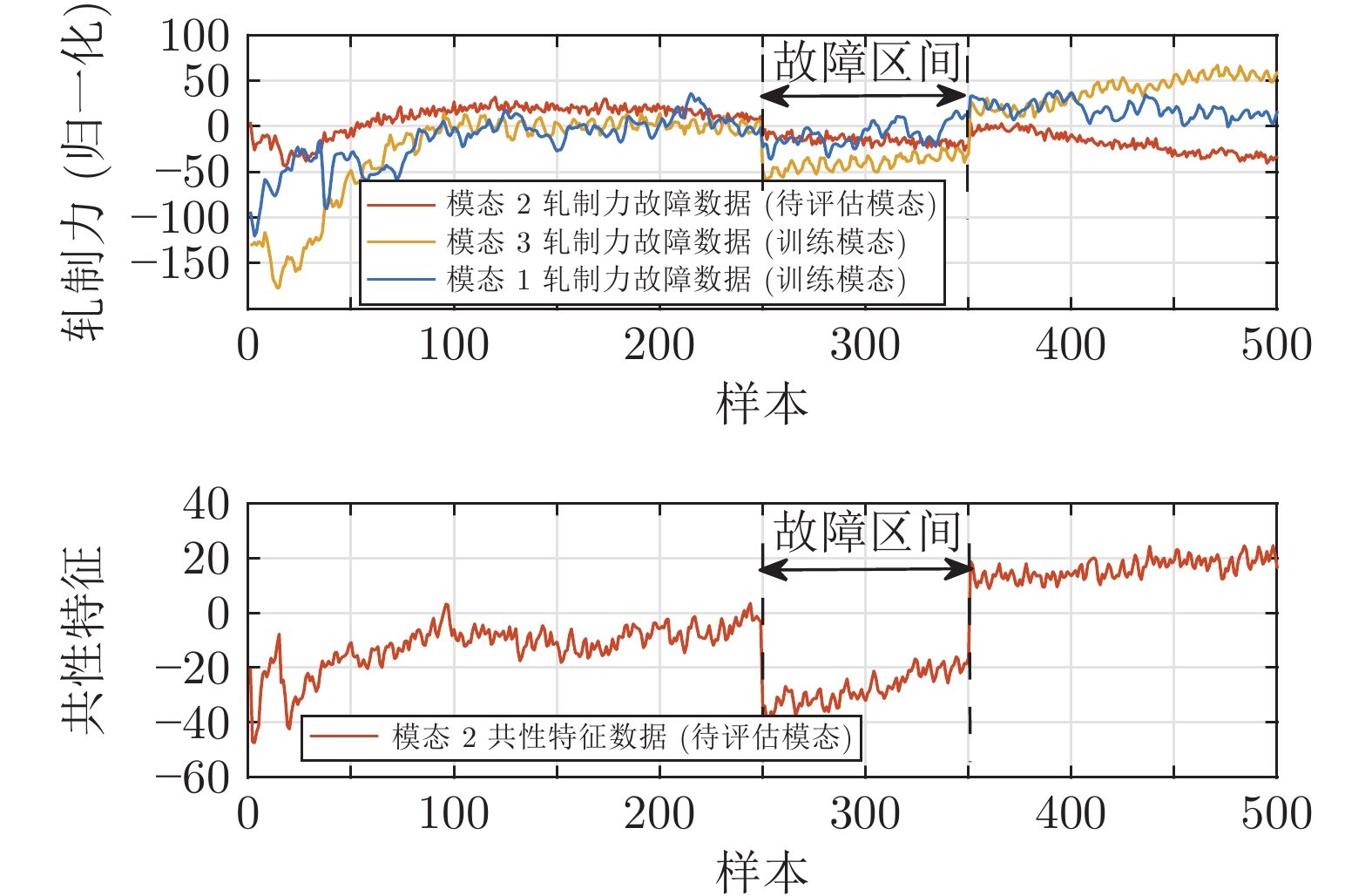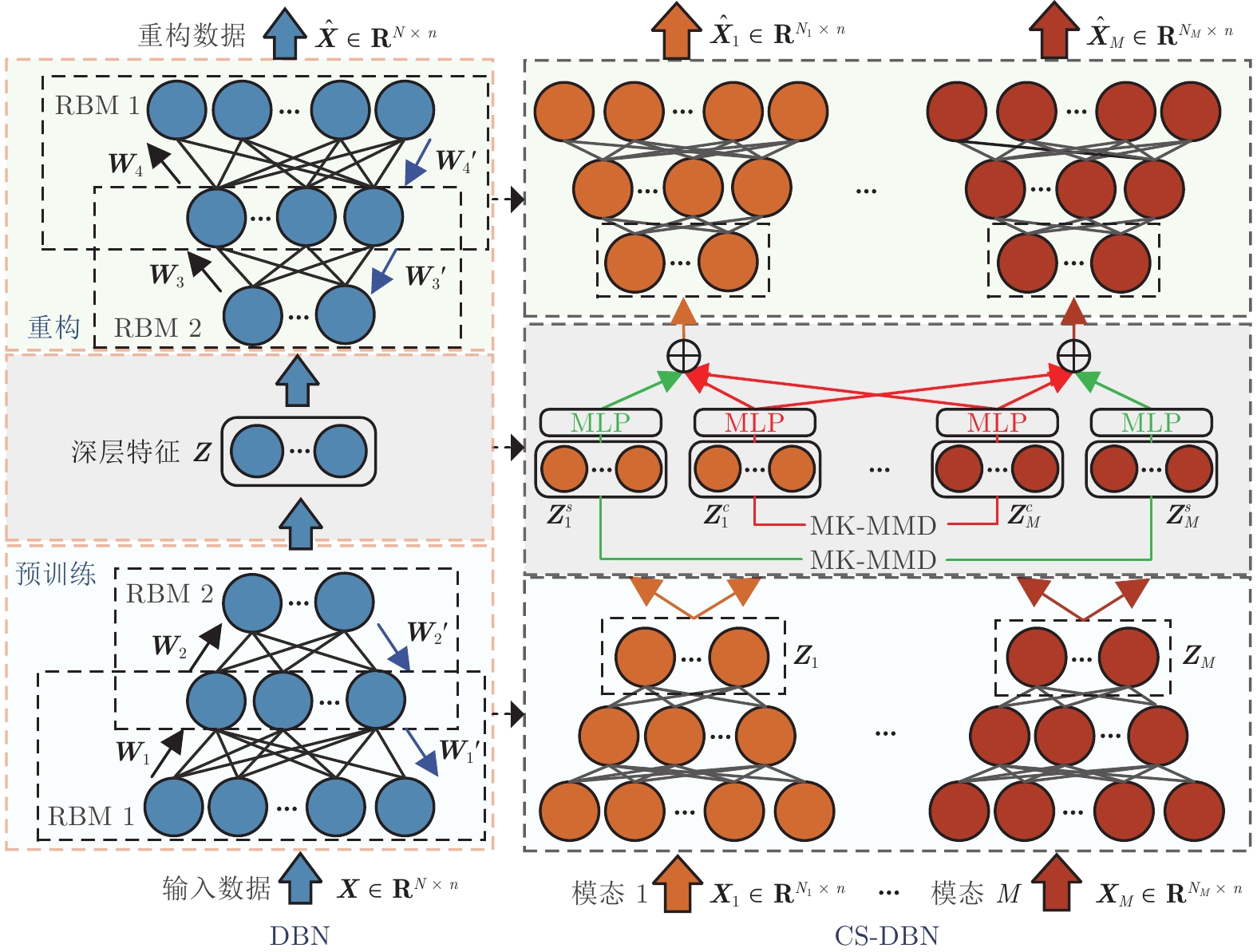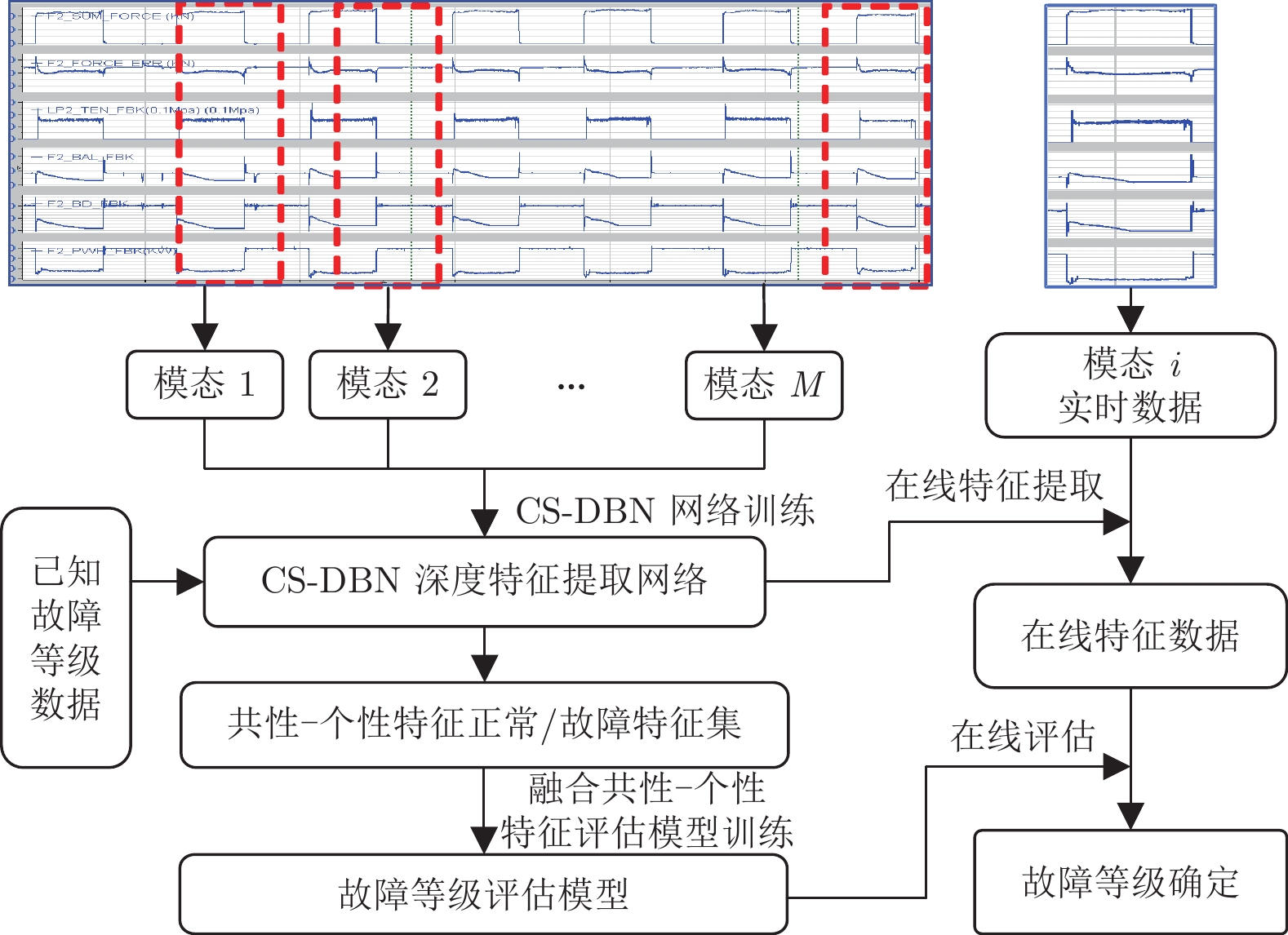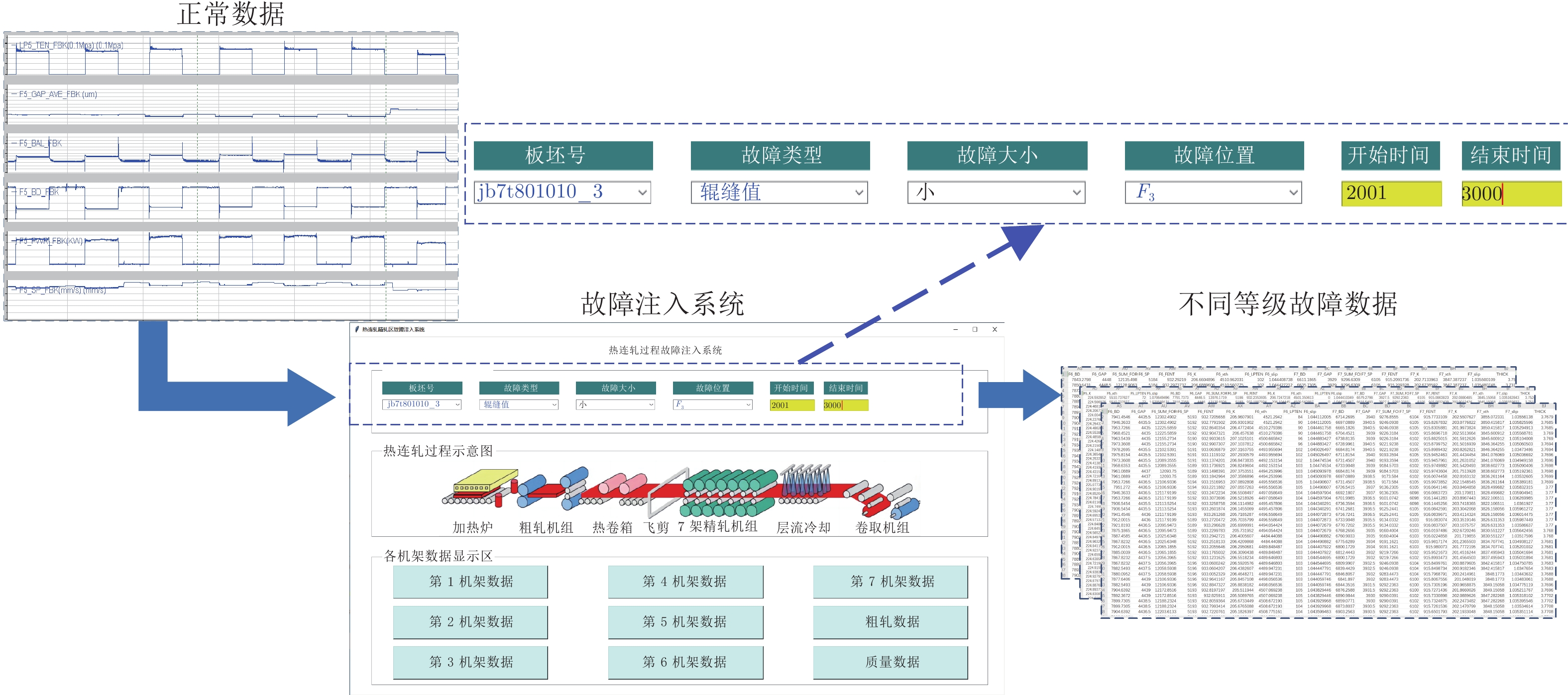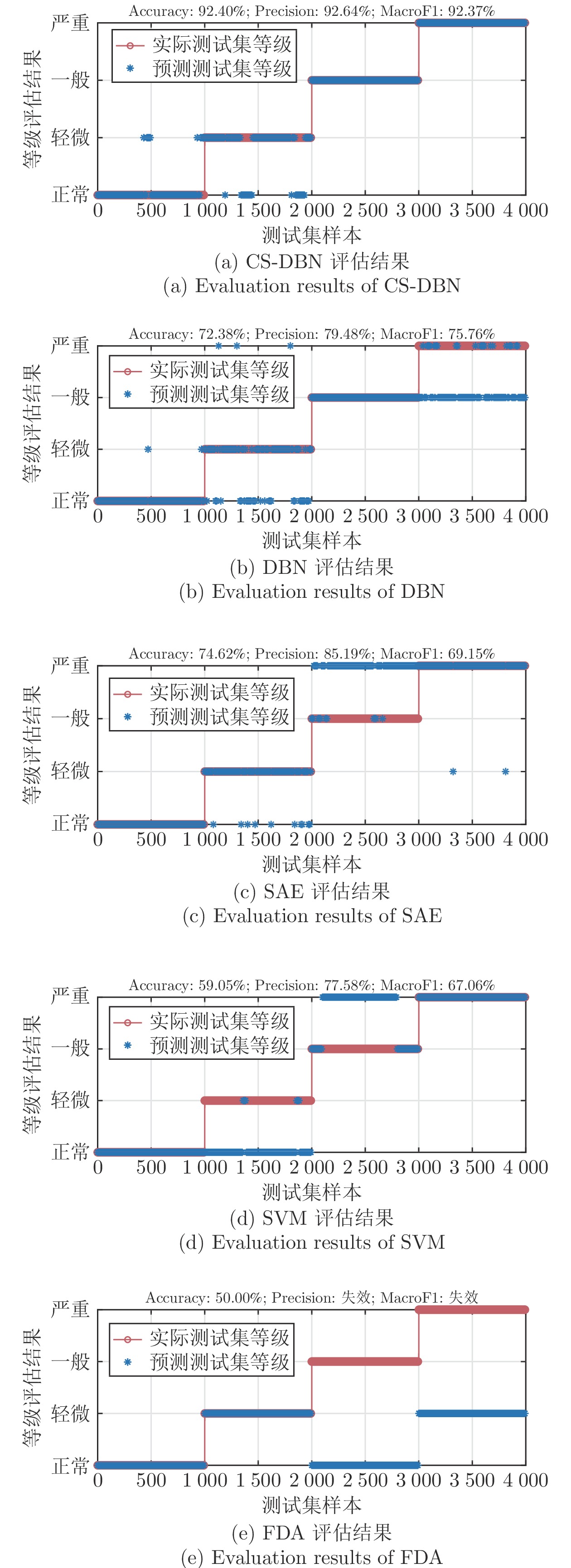A Deep Belief Network-based Fault Evaluation Method for Multimode Processes and Its Applications
-
摘要: 传统的多模态过程故障等级评估方法对模态之间的共性特征考虑较少, 导致当被评估模态故障信息不充分时, 评估的准确性较低. 针对此问题, 首先, 提出一种共性–个性深度置信网络 (Common and specific deep belief network, CS-DBN), 该网络充分利用深度置信网络 (Deep belief network, DBN) 的深度分层特征提取能力, 通过度量多模态数据间分布的相似性和差异性, 进一步得到能够反映多模态过程共有信息的共性特征以及反映每个模态独有信息的个性特征; 其次, 基于CS-DBN, 利用多模态过程的已知故障等级数据生成多模态共性–个性特征集, 通过加权逻辑回归构建故障等级评估模型; 最后, 将所提方法应用于带钢热连轧生产过程的故障等级评估中. 应用结果表明, 随着多模态故障等级数据的增加, 所提方法的评估准确率逐渐增加, 当故障信息充足时, 评估准确率可达98.75%; 故障信息不足时, 与传统方法相比, 评估准确率提升近10%.Abstract: Traditional fault grade evaluation methods for multimode processes have not well consider the common features embedded in multimode process data, which led to the low evaluation accuracy for cases where there lacks of fault grade data for the operating mode under evaluation. To solve this problem, firstly, this paper proposes a common and specific deep belief network (CS-DBN), which fully utilizes the hierarchical feature extraction ability of deep belief network (DBN) to automatically obtain the common features that reflect the common information of multimode operating processes by measuring the similarity and difference in the distribution of multimode operating data, and obtain the specific features reflecting the unique information of each operating mode; Secondly, on the basis of CS-DBN model, the known fault grade data are gathered to formulate a multimode common and specific feature database, and the weighted logical regression method is used to develop a fault grade evaluation model; Finally, the proposed method is applied to the fault grade evaluation problem in a hot rolling mill process. The application results show that, with the increasing amount of multimode fault grade data, the evaluation accuracy of the proposed method gradually increases. For cases that the fault information is sufficient, the evaluation accuracy can reach up to 98.75%; For cases that the fault information is less sufficient, the evaluation accuracy by the proposed method improves nearly 10% compared with traditional methods.
-
表 1 各类共性–个性特征提取方法特点总结
Table 1 Summary of characteristics of various common and specific feature extraction methods
表 2 热连轧过程多模态数据描述
Table 2 Multimode data description of hot continuous rolling process
钢种 规格 (厚度) 工作模态 选取变量 Q235B碳素结构钢 2.30 mm 1 $F_1\sim F_7$辊缝 (mm)
$F_1\sim F_7$轧制力 (KN)
$F_2\sim F_7$弯辊力 (KN)2.70 mm 2 3.00 mm 3 3.95 mm 4 表 3 热连轧过程故障等级划分及标签添加
Table 3 Fault grade division and label addition in the hot continuous rolling process
数据类型 受影响变量 出口厚度差 (mm) 等级 等级标签 正常 无 ±0.01 正常 1 ${F_5}$弯辊力传感器故障 ${F_5}$和${F_6}$弯辊力 ±0.02 轻微故障 2 ${F_4}$辊缝故障 ${F_4}$和${F_5}$辊缝及轧制力 ±0.04 一般故障 3 ${F_2}$与${F_3}$间冷却水阀执行器故障 ${F_3}$至${F_7}$辊缝及轧制力 ±0.08 严重故障 4 表 4 CS-DBN模型参数
Table 4 CS-DBN model parameters
$\varepsilon$ $N_b$ epoch dr $n_c$ $n_s$ ${ \alpha _{re}}$ ${ \alpha _{c}}$ ${ \alpha _{s}}$ 0.0001 80 600 0.5 5 7 0.3 0.2 0.05 表 5 各模态全部故障信息已知下的评估结果 (%)
Table 5 Evaluation results for cases that all fault information in different modes is known (%)
评估指标 FDA SVM SAE DBN CS-DBN Accuracy 82.50 95.27 95.87 93.38 98.75 Precision 89.69 95.34 96.08 94.26 98.96 MacroF1 85.94 95.31 95.98 93.82 98.85 表 6 各模态部分故障信息已知下的评估准确率结果 (%)
Table 6 Evaluation accuracy results for cases that part of fault information in different modes is known (%)
评估指标 案例A: 每个训练模态中包含最多两种等级故障数据下的评估准确率 平均值 A-1 A-2 A-3 A-4 A-5 A-6 A-7 A-8 FDA 57.50 50.00 60.50 65.00 65.00 50.00 50.00 50.00 57.25 SVM 49.70 50.00 50.00 50.00 50.25 50.00 44.85 50.00 49.35 SAE 50.70 50.48 50.82 65.42 54.02 50.20 50.20 50.00 52.73 DBN 53.65 62.45 53.10 50.35 73.10 52.85 57.25 50.20 56.62 CS-DBN 68.23 64.65 64.45 64.40 74.60 67.82 65.45 61.30 66.36 评估指标 案例B: 每个训练模态中均有两种等级故障数据下的评估准确率 平均值 B-1 B-2 B-3 B-4 B-5 B-6 B-7 B-8 FDA 50.00 45.00 25.00 65.25 50.00 52.75 62.50 54.25 50.59 SVM 49.38 50.33 50.01 48.05 41.35 40.75 62.58 50.25 49.09 SAE 57.08 54.25 57.60 50.00 64.65 48.72 63.48 70.20 58.25 DBN 63.62 60.45 68.83 45.53 50.00 72.45 59.50 71.35 61.47 CS-DBN 65.00 85.50 74.00 65.55 73.20 68.15 69.55 74.40 71.92 评估指标 案例C: 每个训练模态中至少有两种等级故障数据下的评估准确率 平均值 C-1 C-2 C-3 C-4 C-5 C-6 C-7 C-8 FDA 50.25 50.00 51.38 50.00 50.00 50.00 50.00 50.00 50.20 SVM 58.43 50.50 50.15 50.25 50.00 58.03 50.00 52.25 52.45 SAE 67.50 60.48 72.95 60.87 60.62 64.55 61.48 70.32 64.85 DBN 71.83 70.50 71.65 71.50 71.28 60.15 74.15 72.70 70.47 CS-DBN 73.63 71.55 74.33 73.05 70.53 74.35 76.95 70.60 73.12 评估指标 案例D: 训练模态中至少有两个模态有三种等级故障数据下的评估准确率 平均值 D-1 D-2 D-3 D-4 D-5 D-6 D-7 D-8 FDA 51.15 50.00 54.38 50.25 52.43 52.45 50.00 52.35 51.63 SVM 53.05 52.35 50.65 50.55 51.85 51.70 52.25 50.00 51.55 SAE 74.52 66.55 68.70 71.45 68.60 70.52 64.43 68.62 69.17 DBN 72.65 69.60 70.83 73.65 74.40 74.05 69.98 66.50 71.46 CS-DBN 87.65 76.43 76.20 88.25 83.30 80.10 76.03 76.35 80.79 -
[1] Zou X Y, Zhao C H. Concurrent assessment of process operating performance with joint static and dynamic analysis. IEEE Transactions on Industrial Informatics, 2020, 16(4): 2776−2786 doi: 10.1109/TII.2019.2934757 [2] Zhu H Q, Wang Q L, Zhang F X, Yang C H, Li Y G, Zhou C. Fuzzy comprehensive evaluation strategy for operating state of electrocoagulation purification process based on sliding window. Process Safety and Environmental Protection, 2022, 165: 217−229 doi: 10.1016/j.psep.2022.06.063 [3] Yu J X, Wu S B, Yu Y, Chen H C, Fan H Z, Liu J H, et al. Process system failure evaluation method based on a Noisy-OR gate intuitionistic fuzzy Bayesian network in an uncertain environment. Process Safety and Environmental Protection, 2021, 150: 281−297 doi: 10.1016/j.psep.2021.04.024 [4] Zou X Y, Zhao C H, Gao F R. Linearity decomposition-based cointegration analysis for nonlinear and nonstationary process performance assessment. Industrial & Engineering Chemistry Research, 2020, 59(7): 3052−3063 [5] Chang L L, Dong W, Yang J B, Sun X Y, Xu X B, Xu X J, et al. Hybrid belief rule base for regional railway safety assessment with data and knowledge under uncertainty. Information Sciences, 2020, 518: 376−395 doi: 10.1016/j.ins.2019.12.035 [6] Zhou X Y, Liu Z J, Wang F W, Wu Z L, Cui R D. Towards applicability evaluation of hazard analysis methods for autonomous ships. Ocean Engineering, 2020, 214: Article No. 107773 doi: 10.1016/j.oceaneng.2020.107773 [7] Fu F Z, Wang D Y, Li W B, Zhao D, Wu Z G. Overall fault diagnosability evaluation for dynamic systems: A quantitative-qualitative approach. Automatica, 2022, 146: Article No. 110591 doi: 10.1016/j.automatica.2022.110591 [8] 褚菲, 赵旭, 代伟, 马小平, 王福利. 数据驱动的最优运行状态鲁棒评价方法及应用. 自动化学报, 2020, 46(3): 439−450Chu Fei, Zhao Xu, Dai Wei, Ma Xiao-Ping, Wang Fu-Li. Data-driven robust evaluation method for optimal operating status and its application. Acta Automatica Sinica, 2020, 46(3): 439−450 [9] 常玉清, 孙雪婷, 钟林生, 王福利, 刘英娇. 基于改进随机森林算法的工业过程运行状态评价. 自动化学报, 2021, 47(9): 2406−2415Chang Yu-Qing, Sun Xue-Ting, Zhong Lin-Sheng, Wang Fu-Li, Liu Ying-Jiao. Industrial operation performance evaluation of industrial processes based on modified random forest. Acta Automatica Sinica, 2021, 47(9): 2406−2415 [10] Peng K X, Guo Y X. Fault detection and quantitative assessment method for process industry based on feature fusion. Measurement, 2022, 197: Article No. 111267 doi: 10.1016/j.measurement.2022.111267 [11] Tao Y, Shi H B, Song B, Tan S. Operating performance assessment and non−optimal cause identification for chemical process. The Canadian Journal of Chemical Engineering, 2019, 97(S1): 1475−1487 doi: 10.1002/cjce.23401 [12] YeongGwang O, Kasin R, Moise B, Daeil K, Namhun K. Adaptive SVM-based real-time quality assessment for primer-sealer dispensing process of sunroof assembly line. Reliability Engineering & System Safety, 2019, 184: 202−212 [13] Wang P, Zhang Z Y, Huang Q, Lee W J. Wind farm dynamic equivalent modeling method for power system probabilistic stability assessment. In: Proceedings of the IEEE Industry Applications Society Annual Meeting. Baltimore, USA: IEEE, 2019. 1−7 [14] Zhao B, Zhang X M, Zhan Z H, Wu Q Q. Deep multi-scale separable convolutional network with triple attention mechanism: A novel multi-task domain adaptation method for intelligent fault diagnosis. Expert Systems With Applications, 2021, 182: Article No. 115087 doi: 10.1016/j.eswa.2021.115087 [15] 褚菲, 傅逸灵, 赵旭, 王佩, 尚超, 王福利. 基于ISDAE模型的复杂工业过程运行状态评价方法及应用. 自动化学报, 2021, 47(4): 849−863Chu Fei, Fu Yi-Ling, Zhao Xu, Wang Pei, Shang Chao, Wang Fu-Li. Operating performance assessment method and application for complex industrial process based on ISDAE model. Acta Automatica Sinica, 2021, 47(4): 849−863 [16] Peng R R, Zhang X Z, Shi P M. Bearing fault diagnosis of hot-rolling mill utilizing intelligent optimized self-adaptive deep belief network with limited samples. Sensors, 2022, 22(20): 7815−7836 doi: 10.3390/s22207815 [17] 王功明, 乔俊飞, 关丽娜, 贾庆山. 深度信念网络研究现状与展望. 自动化学报, 2021, 47(1): 35−49Wang Gong-Ming, Qiao Jun-Fei, Guan Li-Na, Jia Qing-Shan. Review and prospect on deep belief network. Acta Automatica Sinica, 2021, 47(1): 35−49 [18] Ying Y H, Li Z, Yang M L, Du W L. Multimode operating performance visualization and nonoptimal cause identification. Processes, 2020, 8(1): Article No. 123 [19] Ma M, Sun C, Zhang C, Chen X F. Subspace-based MVE for performance degradation assessment of aero-engine bearings with multimodal features. Mechanical Systems and Signal Processing, 2019, 124: 298−312 doi: 10.1016/j.ymssp.2018.12.008 [20] 褚菲, 许杨, 尚超, 王福利, 高福荣, 马小平. 基于静–动态特性协同感知的复杂工业过程运行状态评价. 自动化学报, 2023, 49(8): 1621-1634Chu Fei, Xu Yang, Shang Chao, Wang Fu-Li, Gao Fu-Rong, Ma Xiao-Ping. Evaluation of complex industrial process operating state based on static and dynamic cooperative perception. Acta Automatica Sinica, 2023, 49(8): 1621-1634 [21] Shao W M, Ge Z Q, Yao L, Song Z H. Bayesian nonlinear Gaussian mixture regression and its application to virtual sensing for multimode industrial processes. IEEE Transactions on Automation Science and Engineering, 2020, 17(2): 871−885 doi: 10.1109/TASE.2019.2950716 [22] Lu C Q, Wang S P. Performance degradation prediction based on a Gaussian mixture model and optimized support vector regression for an aviation piston pump. Sensors. 2020, 20(14): 3854−3874 doi: 10.3390/s20143854 [23] Tang L, Hui Y, Yang H, Zhao Y H, Tian C G. Medical image fusion quality assessment based on conditional generative adversarial network. Frontiers in Neuroscience, 2022, 16(8): 986153−986162 [24] Launay H, Ryckelynck D, Lacourt L, Besson J, Mondon A, Willot F. Deep multimodal autoencoder for crack criticality assessment. International Journal for Numerical Methods in Engineering, 2022, 123(6): 1456−1480 doi: 10.1002/nme.6905 [25] 李宝琴, 吴俊勇, 李栌苏, 史法顺, 赵鹏杰, 王燚. 基于主动迁移学习的电力系统暂态稳定自适应评估. 电力系统自动化, 2023, 47(4): 121−132Li Bao-Qin, Wu Jun-Yong, Li Lu-Su, Shi Fa-Shun, Zhao Peng-Jie, Wang Yi. Adaptive assessment of power system transient stability based on active transfer learning. Automation of Electric Power Systems, 2023, 47(4): 121−132 [26] Zhang Y W, Li S. Modeling and monitoring between-mode transition of multimodes processes. IEEE Transactions on Industrial Informatics, 2013, 9(4): 2248−2255 doi: 10.1109/TII.2012.2220977 [27] Gretton A, Sriperumbudur B, Sejdinovic D, Strathmann H, Balakrishnan S, Pontil M, et al. Optimal kernel choice for large-scale two-sample tests. In: Proceedings of the 25th International Conference on Neural Information Processing Systems (NIPS). Lake Tahoe, USA: ACM, 2012. 1205−1213 [28] Hinton G E. Training products of experts by minimizing contrastive divergence. Neural Computation, 2002, 14(8): 1771−1800 doi: 10.1162/089976602760128018 [29] Choo S, Lee H. Learning framework of multimodal Gaussian-Bernoulli RBM handling real-value input data. Neurocomputing, 2018, 275: 1813−1822 doi: 10.1016/j.neucom.2017.10.018 [30] Zhang K, Peng K X, Zhao S S, Chen Z W. A novel common and specific features extraction-based process monitoring approach with application to a hot rolling mill process. Control Engineering Practice, 2020, 104: Article No. 104628 doi: 10.1016/j.conengprac.2020.104628 [31] Zhang K, Peng K X, Zhao S S, Wang F. A novel feature extraction-based process monitoring Method for multimode processes with common features and its applications to a rolling process. IEEE Transactions on Industrial Informatics, 2021, 17(9): 6466−6475 doi: 10.1109/TII.2020.3012024 [32] Jessen H C. Applied logistic regression analysis. Journal of the Royal Statistical Society: Series D (The Statistician), 1996, 45(4): 534−535 -




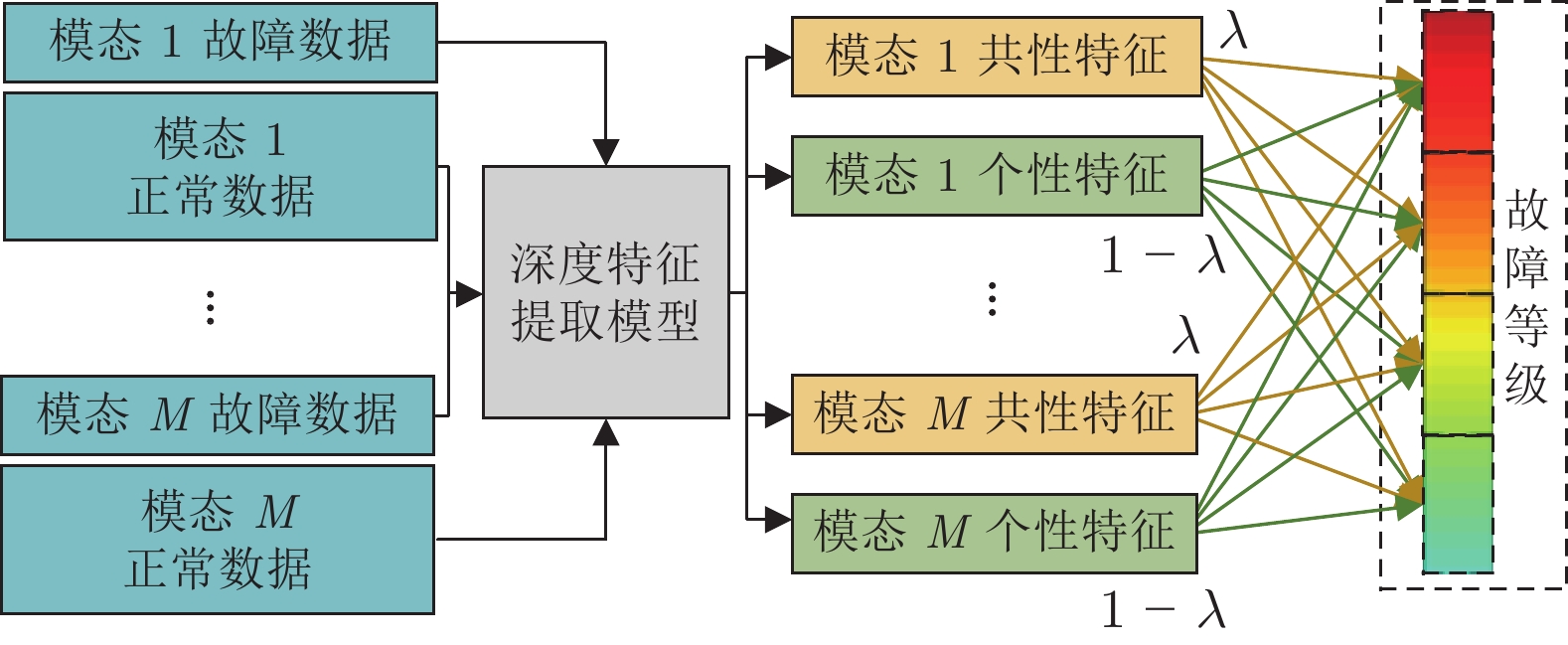
 下载:
下载:

